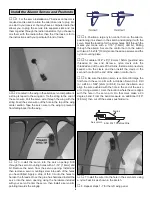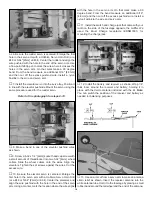
For reassurance and to keep an eye on other traffic, it is a
good idea to have an assistant on the flight line with you. Tell
him to remind you to throttle back once the plane gets to a
comfortable altitude. While full throttle is usually desirable for
takeoff, The Cap 580 does not require full throttle for
anything other than vertical maneuvers. You will find that it
will perform rolls, snaps, inverted flight, knife edge and level
flight at approximately half throttle
Take it easy with the Cap 580 for the first few flights, gradually
getting acquainted with it as you gain confidence. Adjust the
trims to maintain straight and level flight. After flying around
for a while, and while still at a safe altitude with plenty of fuel,
practice slow flight and execute practice landing approaches
by reducing the throttle to see how the model handles at
slower speeds. Add power to see how she climbs as well.
Continue to fly around, executing various maneuvers and
making mental notes (or having your assistant write them
down) of what trim or C.G. changes may be required to fine
tune the model so it flies the way you like. Mind your fuel
level, but use this first flight to become familiar with your
model before landing.
To initiate a landing approach, lower the throttle while on the
downwind leg. Allow the nose of the model to pitch downward
to gradually bleed off altitude. Continue to lose altitude, but
maintain airspeed by keeping the nose down as you turn onto
the crosswind leg. Make your final turn toward the runway (into
the wind) keeping the nose down to maintain airspeed and
control. Level the attitude when the model reaches the runway
threshold, modulating the throttle as necessary to maintain
your glide path and airspeed. If you are going to overshoot,
smoothly advance the throttle (always ready on the right
rudder to counteract torque) and climb out to make another
attempt. When you’re ready to make your landing flare and the
model is a foot or so off the deck, smoothly increase up
elevator until it gently touches down. Once the model is on the
runway and has lost flying speed, hold up elevator to place the
tail on the ground, regaining tail wheel control.
One final note about flying your model. Have a goal or flight
plan in mind for every flight. This can be learning a new
maneuver(s), improving a maneuver(s) you already know, or
learning how the model behaves in certain conditions (such
as on high or low rates). This is not necessarily to improve
your skills (
though it is never a bad idea!), but more
importantly so you do not surprise yourself by impulsively
attempting a maneuver and suddenly finding that you’ve run
out of time, altitude or airspeed. Every maneuver should be
deliberate, not impulsive. For example, if you’re going to do
a loop, check your altitude, mind the wind direction
(anticipating rudder corrections that will be required to
maintain heading), remember to throttle back at the top, and
make certain you are on the desired rates (high/low rates).
A flight plan greatly reduces the chances of crashing your
model just because of poor planning and impulsive moves.
Remember to think.
Have a ball!
But always stay in control and fly in a safe manner.
GOOD LUCK AND GREAT FLYING!
Landing
Flight
22
ALSO AVAILABLE FROM GREAT PLANES
First in affordability and features.
Look at the price, the features and the performance of the 4YF, and
you’ll see why it's the most popular 4-channel around for flight and
surface use. Its FM technology is complemented with NiCds, a charger,
easy access trims and a dual-conversion, 7-channel R127DF receiver.
Two LEDs instantly show battery power status. The trainer system
features a spring-loaded toggle switch instead of a button, so it's easy
to hold "on", and automatically turns "off" when you release it. The
trainer jack features a micro-pin connector port, for less clutter with the
optional cord. Includes four S3004 servos. 1-year warranty. 72 & 75MHz.
Futaba
®
4YF 4-Channel FM Radio FUTJ40**

















